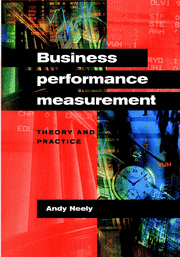Book contents
- Frontmatter
- Contents
- List of contributors
- Preface
- Part I Performance measurement – functional analyses
- Part II Performance measurement – theoretical foundations
- Part III Performance measurement – frameworks and methodologies
- 9 Performance measurement frameworks: A review
- 10 The critical few: First among equals as parameters of strategic effectiveness
- 11 Integrated performance measurement systems: Structure and dynamics
- 12 Why measurement initiatives succeed and fail: The impact of parent company initiatives
- Part IV Performance measurement – practical applications
- Part V Performance measurement – specific measures
- Part VI Performance measurement – emerging issues and trends
- Index
10 - The critical few: First among equals as parameters of strategic effectiveness
from Part III - Performance measurement – frameworks and methodologies
Published online by Cambridge University Press: 06 July 2010
- Frontmatter
- Contents
- List of contributors
- Preface
- Part I Performance measurement – functional analyses
- Part II Performance measurement – theoretical foundations
- Part III Performance measurement – frameworks and methodologies
- 9 Performance measurement frameworks: A review
- 10 The critical few: First among equals as parameters of strategic effectiveness
- 11 Integrated performance measurement systems: Structure and dynamics
- 12 Why measurement initiatives succeed and fail: The impact of parent company initiatives
- Part IV Performance measurement – practical applications
- Part V Performance measurement – specific measures
- Part VI Performance measurement – emerging issues and trends
- Index
Summary
The importance of defining the critical few
In today's complex and rapidly changing business environment, a strategic plan is an executive team's blueprint for changing the organization and growth. The process undertaken to develop that plan provides executives and other stakeholders with the opportunity to periodically re-think the business in a creative manner. In doing so, they can develop a shared understanding of what will be critical for future success, as well as enhance their knowledge of the business and its possible future environment. In our experience, if during this process executives are forced to make hard choices about what is critical, and focus future strategy around a limited (3–5) set of initiatives with associated specific, measurable objectives, the critical few, implementation effectiveness will be significantly improved, and organizational performance will be enhanced.
In this chapter, we provide the results of a research study which makes the case, previously only supported anecdotally, that building shared understanding among the executive team, of the critical few corporate initiatives, has a positive impact on strategic planning effectiveness, and hence on organizational performance. In describing our study more fully, this introductory section is followed by a discussion of the practical challenges in creating a shared understanding of the critical few. We then outline the process we have found useful for overcoming these challenges, enabling the definition of a highly focused strategic agenda – something we believe can be done for any organization, no matter how large or small. The chapter concludes with a discussion of our research approach, the research findings, and the implications of these findings for corporations and the executives who lead them.
- Type
- Chapter
- Information
- Business Performance MeasurementTheory and Practice, pp. 156 - 173Publisher: Cambridge University PressPrint publication year: 2002



